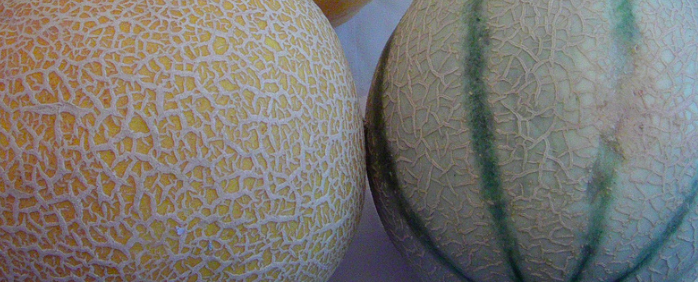
Our intention here is to offer you a holistic approach: to begin by understanding where the wild species comes from, to deduce the needs and preferences of our current varieties . From there, we will give you the keys to understand the interest of different cultural gestures, or why you can avoid some.
Description of the species.
The melon, Cucumis melo L. is an annual plant with creeping stems. Its fruits are harvested normally from July to September; according to the varieties they can be covered with a smooth or grooved gray bark, but also “embroidered”, of yellow or green color, and of spherical or ovoid shape.
A species cultivated for a very long time
The wild melon, Cucumis melo L. is a species of the Cucurbitaceae family, native to intertropical Africa , unlike its cousins the squash, which come from America. The fruit has long been acclimatized in Asia and Mediterranean Europe. The domestication of the first melons is very old, since they were already cultivated during antiquity, first in Egypt, then in Greece and Italy.
This fruit is originally unsweetened, and it is by acclimatizing Asian varieties – Asia Minor and India – that have been developed since the Renaissance the sweet varieties from which our current melons descend. The melon ‘Cantaloup’ is the first to have been introduced in France. Most of the old French varieties come from the varietal group ‘Cantaloupe’. Since the mid-twentieth century the vast majority of French production has come mainly from varietal selections in the group of green melon with well-marked neighborhoods ‘Cantaloup Charentais’ .
You wonder why are you told that? Well first of all it explains why you will find very different melons if you go to make your market in Italy or in Spain, which do not cultivate only ‘Cantaloup Charentais’. Other countries use American, Italian, Turkish or even Israeli varieties.
Where to grow melons, and with what equipment?
The consequence of this varietal journey is that we now grow descendants of Indian varieties first acclimated to the Mediterranean basin. We must force things to grow in the hexagon, especially north of the Loire.
The culture in the frame is always advised for many varieties because they love the heat. Moisture on the leaves and stagnant air can facilitate the development of diseases, so air regularly, do not wet the leaves at night or place two melons in the same place for two years.
Should we really sow indoors?
Melons germinate better between 24 and 35 ° C … so not only it is better to sow them indoors, but they must be placed in a very warm place in the house. The other option is the “warm layer”, where you use the heat released by the decomposition of your compost to warm your crops. In all cases, these seedlings are done early in the season, to transplant plants well developed and less sensitive to parasites.
Why do you have to cut some varieties of melon?
This is exactly the same case as for tomatoes, we try to force the fruiting of a plant accustomed to sunshine and a tropical climate. In the tropics, plants have 12 warm months, while in the northern hemisphere, we have only 4 to 6 months favorable. So it’s a question of not “dispersing” to make leaves , and to attack as soon as possible the formation of the fruits!
Modern varieties are earlier, there is no need to constrain them. On the other hand, for older varieties – more adapted to southern climates – it is necessary to force nature. It’s up to you to experiment according to your garden and its location, but sometimes it is necessary to be limited to 4 fruits per foot, and to a leaf by fruit.
How to find among the varieties?
In the world of melons, there are the ‘Cantaloup’ which gave many varieties cultivated in Northern Europe, including the ‘Cantaloup Charentais’ cultivar group. Then, we distinguish between the old varieties – the nineteenth and the beginning of the twentieth century – modern varieties and their hybrids.
The recent hybrid varieties of Melon Charentais have been developed to make the fruit firmer, to facilitate the transport and holding on shelf. This is of little interest to you, amateur gardeners, so you can grow the old varieties like ‘Petit Gris de Rennes’ or ‘Sucrin de Tours’ without hesitation.
The other specificity of the hybrids is that they are more resistant to the aggressors, which makes it necessary to monitor more the felted spots – the mildew – on the old varieties. And above all, do not wet the leaves!
Important detail to check before you decide: some varieties are monoecious – male flowering feet and female flowering feet – so it will take several feet to achieve pollination. Easy to recognize the kind of a flower: the female flowers have a bulge under the base of the petals.
Turn the melons!
No, this is not the new fashionable game in schoolyards, we are talking about rotation in the garden!
It is especially important not to replant melons in one place for several reasons.
First, spores of parasitic fungi are more concentrated in the soil around the plant. As a result, planting seedlings whose tissue wall is still thin in a “mined” area of spores is the recipe for disaster.
Second, like all good Cucurbitaceae melons are greedy plants – especially potash – so they tire the soil. Of course, you must be careful not to place it in a location that would have been used by another Cucurbitaceae unless you have composted it before winter.
You’ll understand, we do not compromise easily with melons. The lack of small fruit varieties – such as cherry tomatoes for tomatoes – does not shorten the cultivation time, and it is truly a species that can not do without heat and sun.